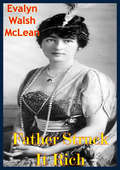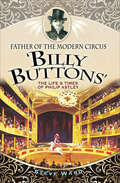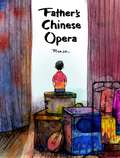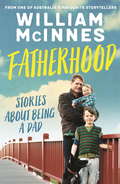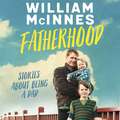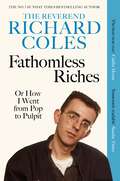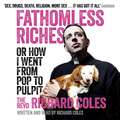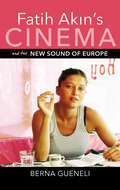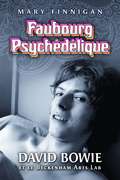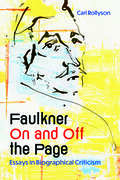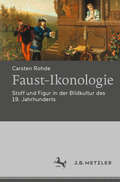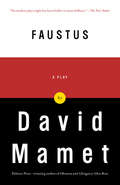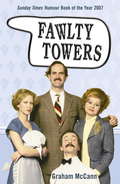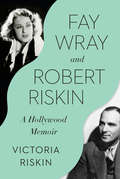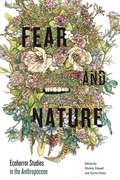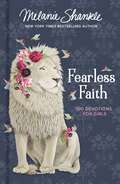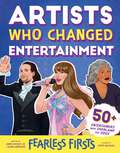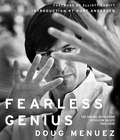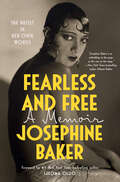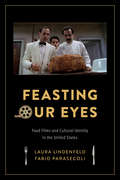- Table View
- List View
Father Struck It Rich (Leisure Class In America Ser.)
by Evalyn Walsh Mclean Boyden SparkesThomas Walsh discovered fabulous golden wealth in the historic Camp Bird Mine near Ouray, Colorado. His daughter, Evalyn Walsh McLean, tells an engaging true story of the family that wanted for nothing. They led a life of extravagance. It enabled them to acquire possessions such as the Hope Diamond and the fabulous homes that hosted spectacular social functions and served as retreats for kings and presidents.-Print ed.
Father of the Modern Circus 'Billy Buttons': The Life & Times of Philip Astley
by Steve WardThe world of the circus has a long and colorful history but it was with a man named Philip Astley that the modern circus was founded. It was 250 years ago, in April 1768, that Astley pegged out a circular ride on the banks of the river Thames and gave performances of trick riding to a paying audience. Trick riding was nothing new, so what made Astley so popular? He was an accomplished horseman, a military hero and an instinctive showman. Above all, he was an entrepreneur who realized that people would pay good money to be entertained and to be entertained well. He created the comic character of Billy Buttons, and other acts were added to his performances: clowns, rope dancers, tumblers and strongmen. The circus, as we might recognize it today, was born.Father of the Modern Circus Billy Buttons investigates the life and times of this veritable giant of the circus world. Standing well over 6 feet tall, with a stentorian voice and character to match, it was difficult to ignore him wherever he went. From his early days as an apprentice cabinetmaker and his military exploits in the 15th Dragoons to the trials and tribulations of establishing himself as a respected performer and his international successes in France and Ireland, this book gives a detailed account of the larger than life figure that was Philip Astley.
Father's Chinese Opera
by Rich LoThe Chinese opera is anything but boring. Songs, acrobatics, acting, and costumes make the opera a truly spectacular show to behold. Spending a summer backstage at his father's Chinese opera, a young boy is instantly enamored with the performers and works hard to be a part of the show. Rehearsing the moves day and night with the show's famous choreographer, the boy thinks he is soon ready to perform with the others. But the choreographer doesn't agree. In fact, he laughs at the boy when asked to join the others in the acrobatics part of the opera. Upset, the boy runs home to sulk. What will he do next? Will he give up, or will he persevere and work his way up in the show? <p><p> In an exotic and intriguing story that draws on author Rich Lo's personal life, and features his own bright, mesmerizing illustrations, Father's Chinese Opera teaches children about hard work, patience, and the commitment needed to achieve an important goal, while introducing them to an important part of Chinese culture.
Fatherhood: Stories about being a dad
by William McInnesWilliam McInnes, one of Australia's best-known storytellers and actors, has turned to a subject that is close to his heart. Fatherhood is about family, about memories of his father and the memories he's creating as a dad himself, with his own son and daughter.Warm, witty and nostalgic, these tales are just like a friendly chat over the back fence, or the banter of a backyard BBQ. They will stir your own memories: of hot summer days and cooling off under the sprinkler while Dad works in the garden with the radio tuned to the sports results; that time Dad tried to teach you to drive - and then got out of the car and kissed the ground; or taking your own kids on a family road trip.Fatherhood is full of memories: the happy, the hilarious, the sad, bad, and the unexpectedly poignant moments. You will laugh, you may even cry - but you will recognise yourself and those you love somewhere in these pages.
Fatherhood: Stories about being a dad
by William McInnesWilliam McInnes, one of Australia's best-known storytellers and actors, has turned to a subject that is close to his heart. Fatherhood is about family, about memories of his father and the memories he's creating as a dad himself, with his own son and daughter.Warm, witty and nostalgic, these tales are just like a friendly chat over the back fence, or the banter of a backyard BBQ. They will stir your own memories: of hot summer days and cooling off under the sprinkler while Dad works in the garden with the radio tuned to the sports results; that time Dad tried to teach you to drive - and then got out of the car and kissed the ground; or taking your own kids on a family road trip.Fatherhood is full of memories: the happy, the hilarious, the sad, bad, and the unexpectedly poignant moments. You will laugh, you may even cry - but you will recognise yourself and those you love somewhere in these pages.
Fathomless Riches: Or How I Went From Pop to Pulpit
by Reverend Richard ColesThe memoir of popular BBC Radio 4 SATURDAY LIVE presenter and former member of the Communards, the Reverend Richard Coles.'I love @RevRichardColes SO MUCH' Caitlin MoranFATHOMLESS RICHES is the Reverend Richard Coles's warm, witty and wise memoir in which he divulges with searing honesty and intimacy his pilgrimage from a rock-and-roll life of sex and drugs in the Communards to one devoted to God and Christianity. The result is one of the most unusual and readable life stories of recent times, and has the power to shock as well as to console.
Fathomless Riches: Or How I Went From Pop to Pulpit
by Reverend Richard ColesA parish priest in Northamptonshire; a former rock-star whose number-one hit with The Communards was the biggest-selling single of 1986; the regular host of BBC Radio 4's SATURDAY LIVE - these three people are not usually embodied in one person. The Reverend Richard Coles' memoir offers his rich and personal insights into one of the most diverse of lives, encompassed with the wit and humour he brings to his popular radio show. Richard Coles gives the phrase 'time management' a new emphasis. From conducting the funeral of a cross-dressing farmer and recording an interview with a Californian who believes he was abducted by aliens, to a lunch meeting with the Mothers Union, then making an after-dinner speech to a roomful of thoughtful actuaries, his work has taken him from food-fights in a Swiss hotel with the Beastie Boys to propitiating the gods of the sea as Deputy Chaplain to the Admiral of the Wash on his annual inspection of the Beacons and Buoys.Mirroring the Christian calendar with its narrative of birth, death and renewal, from Advent to Christmas, from Lent to Easter, Richard Coles gives an honest and lighthearted account of the drama that comes with fulfilling so many roles, and the daily challenges that accompany it.Fathomless Riches - a phrase characteristic of St Paul and his followers - is the indescribable generosity, love and sheer surprise that Richard Coles encounters through a life of faith. The result is one of the most readable and illuminating autobiographies of the year.Read by the author(p) 2014 Orion Publishing Group
Fathomless Riches: Or How I Went From Pop to Pulpit
by Richard ColesThe Reverend Richard Coles is a parish priest in Northamptonshire and a regular host of BBC Radio 4's Saturday Live. He is also the only vicar in Britain to have had a number 1 hit single: the Communards' 'Don't Leave Me This Way' topped the charts for four weeks and was the biggest-selling single of its year. Fathomless Riches is his remarkable memoir in which he divulges with searing honesty and intimacy his pilgrimage from a rock-and-roll life of sex and drugs to a life devoted to God and Christianity. Music is where it began. Richard Coles was head chorister at school, and later discovered a love of saxophone together with the magic of Jimmy Somerville's voice. Against a backdrop of intense sexual and political awakening, the Communards were formed, and Richard Coles's life as a rock star began. Fathomless Riches - a phrase characteristic of St Paul and his followers - is a deeply personal and illuminating account of a transformation from hedonistic self-abandonment to 'the moment that changed everything'. Funny, warm, witty and wise, it is a memoir which has the power to shock as well as to console. It will be hailed as one of the most unusual and readable life stories of recent times.
Fatih Akin's Cinema and the New Sound of Europe (New Directions in National Cinemas)
by Berna GueneliIn Fatih Akın’s Cinema and the New Sound of Europe, Berna Gueneli explores the transnational works of acclaimed Turkish-German filmmaker and auteur Fatih Akın. The first minority director in Germany to receive numerous national and international awards, Akın makes films that are informed by Europe’s past, provide cinematic imaginations about its present and future, and engage with public discourses on minorities and migration in Europe through his treatment and representation of a diverse, multiethnic, and multilingual European citizenry. Through detailed analyses of some of Akın’s key works—In July, Head-On, and The Edge of Heaven, among others—Gueneli identifies Akın’s unique stylistic use of multivalent sonic and visual components and multinational characters. She argues that the soundscapes of Akın’s films—including music and multiple languages, dialects, and accents—create an “aesthetic of heterogeneity” that envisions an expanded and integrated Europe and highlights the political nature of Akın’s decisions regarding casting, settings, and audio. At a time when belonging and identity in Europe is complicated by questions of race, ethnicity, religion, and citizenship, Gueneli demonstrates how Akın’s aesthetics intersect with politics to reshape notions of Europe, European cinema, and cinematic history.
Faubourg Psychédélique: David Bowie et le Beckenham Arts Lab
by Mary FinniganCeci est la traduction française de Psychédélic Suburbia - traduit par Faubourg Psychédélique, écrit par Mary Finnigan, relatant sa relation avec le chanteur David Bowie et les premières étapes de sa carrière à Beckenham (banlieue sud de Londres) avant qu’il ne devienne une des pop stars mondiales le plus emblématiques.
Faulkner On and Off the Page: Essays in Biographical Criticism
by Carl RollysonThough numerous biographies have been published on William Faulkner, readers are often presented conflicting interpretations of his life and work. Faulkner’s view of himself and his own family was mercurial, and it is widely acknowledged that Faulkner was an unreliable narrator of his own life. As a result, biographies of Faulkner echo and complicate the multitude of ways he portrayed himself, accepting that truth—if it exists—is subjective. Like his work, Faulkner’s own life, then, is not only open to different readings but welcomes them within the landscape of his oeuvre.Faulkner On and Off the Page acknowledges the challenges of “factifying” a life into a textual narrative, while also emphasizing the potential for biography to establish a throughline that traces how literature emerges from life and, in turn, shapes the life narrative Faulkner constructed for himself. Unburdened by the sanctity of the written word, Faulkner embraced mutability and perpetual evolution. This process of reinvention also manifests within the pages of Faulkner's biographies, as each biographer brings a unique context and perspective shaped by generations of Faulkner scholars.Rather than thinking of Faulkner as exclusively the great high modernist who strayed to Hollywood when he needed the money and stayed home when he didn’t, this book portrays an unsettled writer incessantly on the move incorporating what only looked like alien elements into his work, while maintaining a public persona that disparaged anything that did not fit the narrative of the novelist he created in interviews, essays, and speeches. This book attempts to carry on the work of finding the man on the page even as he is shaping a life off of it.
Faust-Ikonologie: Stoff und Figur in der Bildkultur des 19. Jahrhunderts
by Carsten RohdeDie Geschichte des Faust-Stoffes seit Goethe ist lange Zeit vor allem unter ideologischen Gesichtspunkten gedeutet worden. Die vorliegende Studie untersucht erstmals tiefergehend die populärkulturellen Resonanzen von Faust in der sich formierenden Medienmoderne des 19. Jahrhunderts. Die ‚Explosion der Bilder‘ sorgt dafür, dass Stoff und Figur in einer nie dagewesenen Vielfalt und Breite als visuelles Phänomen in Erscheinung treten. Faust wird zu einer populären Projektions- und Identifikationsfigur, die mit ganz unterschiedlichen Formen, Funktionen und Kontexten in Verbindung steht. Ihre Omnipräsenz in der Bildkultur des Jahrhunderts ist sowohl Spiegel als auch Katalysator dieser Entwicklungen.
Faustus
by David MametHaving put his personal stamp on the contemporary theater, David Mamet now performs the supremely audacious feat of reinventing the theater of the past. He does so by telling his own ingenious and eerily moving version of the tragedy of Dr. Faustus. Mamet's Faustus--like Marlowe's and Goethe's before him--is a philosopher whose life's work has been the pursuit of "the secret engine of the world." He is also the distracted father of a small, adoring son. Out of the clash between love and intellect and the fatal operation of Faustus' pride, Mamet fashions a work that is at once caustic and heart-wrenching and whose resplendent language marries metaphysics to conman's patter. A meditation on reason and folly, fathers and sons, and a breathtaking display of magic both literal and theatrical, Faustus is a triumph.
Fawlty Towers
by Graham McCannFawlty Towers was only on our screens for 12 half-hour episodes, but it has stayed in our lives ever since. The Major; 'Don't mention the war!'; 'He's from Barcelona'; Basil the Rat -- everyone has a favourite line, moment or character. In this, the first biography of the show, Graham McCann holds up to the light each of the unpredictable elements - the demented brilliance of John Cleese, his creative partnership with Connie Booth - that added up to an immortal sitcom, beloved all over the world, even in Barcelona.
Fawlty Towers
by Graham MccannFawlty Towers was only on our screens for 12 half-hour episodes, but it has stayed in our lives ever since. The Major; 'Don't mention the war!'; 'He's from Barcelona'; Basil the Rat -- everyone has a favourite line, moment or character. In this, the first biography of the show, Graham McCann holds up to the light each of the unpredictable elements - the demented brilliance of John Cleese, his creative partnership with Connie Booth - that added up to an immortal sitcom, beloved all over the world, even in Barcelona.
Fay Wray and Robert Riskin: A Hollywood Memoir
by Victoria RiskinA Hollywood love story, a Hollywood memoir, a dual biography of two of Hollywood’s most famous figures, whose golden lives were lived at the center of Hollywood’s golden age, written by their daughter, an acclaimed writer and producer.Fay Wray was most famous as the woman—the blonde in a diaphanous gown—who captured the heart of the mighty King Kong, the twenty-five-foot, sixty-ton gorilla, as he placed her, nestled in his eight-foot hand, on the ledge of the 102-story Empire State Building, putting Wray at the height of New York’s skyline and cinematic immortality. Wray starred in more than 120 pictures opposite Hollywood's biggest stars—Spencer Tracy, Gary Cooper (The Legion of the Condemned, The First Kiss, The Texan, One Sunday Afternoon), Clark Gable, William Powell, and Charles Boyer; from cowboy stars Hoot Gibson and Art Accord to Ronald Colman (The Unholy Garden), Claude Rains, Ralph Richardson, and Melvyn Douglas. She was directed by the masters of the age, from Fred Niblo, Erich von Stroheim (The Wedding March), and Mauritz Stiller (The Street of Sin) to Leo McCarey, William Wyler, Gregory La Cava, “Wild Bill” William Wellman, Merian C. Cooper (The Four Feathers, King Kong), Josef von Sternberg (Thunderbolt), Dorothy Arzner (Behind the Make-Up), Frank Capra (Dirigible), Michael Curtiz (Doctor X), Raoul Walsh (The Bowery), and Vincente Minnelli.The book’s—and Wray’s—counterpart: Robert Riskin, considered one of the greatest screenwriters of all time. Academy Award–winning writer (nominated for five), producer, ten-year-long collaborator with Frank Capra on such pictures as American Madness, It Happened One Night, Mr. Deeds Goes to Town, Lost Horizon, and Meet John Doe, hailed by many, among them F. Scott Fitzgerald, as “among the best screenwriters in the business.” Riskin wrote women characters who were smart, ornery, sexy, always resilient, as he perfected what took full shape in It Happened One Night, the Riskin character, male or female—breezy, self-made, streetwise, optimistic, with a sense of humor that is subtle and sure.Fay Wray and Robert Riskin lived large lives, finding each other after establishing their artistic selves and after each had had many romantic attachments—Wray, an eleven-year-long difficult marriage and a fraught affair with Clifford Odets, and Riskin, a series of romances with, among others, Carole Lombard, Glenda Farrell, and Loretta Young.Here are Wray’s and Riskin’s lives, their work, their fairy-tale marriage that ended so tragically. Here are their dual, quintessential American lives, ultimately and blissfully intertwined.
Fear and Nature: Ecohorror Studies in the Anthropocene (AnthropoScene)
by Christy Tidwell Carter SolesEcohorror represents human fears about the natural world—killer plants and animals, catastrophic weather events, and disquieting encounters with the nonhuman. Its portrayals of animals, the environment, and even scientists build on popular conceptions of zoology, ecology, and the scientific process. As such, ecohorror is a genre uniquely situated to address life, art, and the dangers of scientific knowledge in the Anthropocene.Featuring new readings of the genre, Fear and Nature brings ecohorror texts and theories into conversation with other critical discourses. The chapters cover a variety of media forms, from literature and short fiction to manga, poetry, television, and film. The chronological range is equally varied, beginning in the nineteenth century with the work of Edgar Allan Poe and finishing in the twenty-first with Stephen King and Guillermo del Toro. This range highlights the significance of ecohorror as a mode. In their analyses, the contributors make explicit connections across chapters, question the limits of the genre, and address the ways in which our fears about nature intersect with those we hold about the racial, animal, and bodily “other.”A foundational text, this volume will appeal to specialists in horror studies, Gothic studies, the environmental humanities, and ecocriticism.In addition to the editors, the contributors include Kristen Angierski, Bridgitte Barclay, Marisol Cortez, Chelsea Davis, Joseph K. Heumann, Dawn Keetley, Ashley Kniss, Robin L. Murray, Brittany R. Roberts, Sharon Sharp, and Keri Stevenson.
Fear and Nature: Ecohorror Studies in the Anthropocene (AnthropoScene: The SLSA Book Series #8)
by Christy Tidwell Carter SolesEcohorror represents human fears about the natural world—killer plants and animals, catastrophic weather events, and disquieting encounters with the nonhuman. Its portrayals of animals, the environment, and even scientists build on popular conceptions of zoology, ecology, and the scientific process. As such, ecohorror is a genre uniquely situated to address life, art, and the dangers of scientific knowledge in the Anthropocene.Featuring new readings of the genre, Fear and Nature brings ecohorror texts and theories into conversation with other critical discourses. The chapters cover a variety of media forms, from literature and short fiction to manga, poetry, television, and film. The chronological range is equally varied, beginning in the nineteenth century with the work of Edgar Allan Poe and finishing in the twenty-first with Stephen King and Guillermo del Toro. This range highlights the significance of ecohorror as a mode. In their analyses, the contributors make explicit connections across chapters, question the limits of the genre, and address the ways in which our fears about nature intersect with those we hold about the racial, animal, and bodily "other."A foundational text, this volume will appeal to specialists in horror studies, Gothic studies, the environmental humanities, and ecocriticism.In addition to the editors, the contributors include Kristen Angierski, Bridgitte Barclay, Marisol Cortez, Chelsea Davis, Joseph K. Heumann, Dawn Keetley, Ashley Kniss, Robin L. Murray, Brittany R. Roberts, Sharon Sharp, and Keri Stevenson.
Fearless (Fearless Series #1)
by Mandy GonzalezBetter Nate than Ever meets Love Sugar Magic in this spooky middle grade novel from Hamilton and Broadway star Mandy Gonzalez about a group of young thespians who must face the ghost haunting their theater.Twelve-year-old Monica Garcia has arrived in NYC with her grandmother and a few suitcases to live her dream on Broadway. She&’s been chosen as understudy to the star of Our Time, the famed Ethel Merman Theater&’s last chance to produce a hit before it shutters its doors for good. Along with her fellow castmates—a.k.a. &“the squad&”—Monica has a big and very personal reason to want this show to succeed. But rumors of a long-running curse plague the theater. And when strange and terrible things start to threaten their hopes for a successful opening night, Monica and the rest of the squad must figure out how to reverse the curse before their big Broadway debuts. With the help of her new friends, her family, and a little magic, can Monica help save the show—and save their dreams? From Broadway and television star Mandy Gonzalez comes a story about what it means to dream, be yourself, and be fearless.
Fearless Faith: 100 Devotions for Girls (Faithgirlz)
by Melanie ShankleFrom popular blogger and New York Times bestselling author Melanie Shankle comes Fearless Faith: 100 Devotions for Girls. An interactive devotional, each day&’s reading encourages girls to be confident in their faith as well as grow in that faith and the knowledge they can impact the world around them.Each devotional speaks directly to tween and teen girls with:Reader-friendly &“Day 1,&” &“Day 2&” format, allowing girls to start at any time of yearEasy-to-read and relatable textA Scripture verse, an encouraging message, and a corresponding activity or set of questions to frame the day&’s takeaway in the real worldUnique challenges and engaged questions such as: What are three things that make you happy? What do you worry about? What do you think God wants for your life?Fearless Faith is a devotional perfect for birthdays, holiday gift giving, or as a token of encouragement.
Fearless Firsts: Artists Who Changed Entertainment (Fearless Firsts)
by Ellen Labrecque James Buckley Jr.Celebrate 50+ artists who broke barriers, took risks, and changed the world of entertainment forever!While these creatives came from different backgrounds and overcame unique struggles, they had one thing in common: they would not take "You can't" for an answer. With a don't-give-up attitude, these fearless firsts fought for what they believed in and created a better artistic world.In this book, you'll read about very famous entertainers, like Taylor Swift and Oprah Winfrey. You'll also discover the first Asian American comic book writer and the first runway model in a wheelchair. You'll meet the world's first modern graffiti artist, the first Black man to host a TV series, and the first Indigenous American Oscar winner. Beyond individuals, you'll learn about important groups, like the East West Players and the Hamilton cast. By the time you're done reading, whether you see yourself as an artist or not, you'll be inspired to stay optimistic, fight against injustice, and be fearless in whatever you set your mind to!
Fearless Genius
by Kurt Andersen Elliot Erwitt Doug MenuezAn eye-opening chronicle of the Silicon Valley technology boom, capturing key moments in the careers of Steve Jobs and more than seventy other leading innovators as they created today's digital world In the spring of 1985, a technological revolution was under way in Silicon Valley, and documentary photographer Doug Menuez was there in search of a story--something big. At the same time, Steve Jobs was being forced out of his beloved Apple and starting over with a new company, NeXT Computer. His goal was to build a supercomputer with the power to transform education. Menuez had found his story: he proposed to photograph Jobs and his extraordinary team as they built this new computer, from conception to product launch. In an amazing act of trust, Jobs granted Menuez unlimited access to the company, and, for the next three years, Menuez was able to get on film the spirit and substance of innovation through the day-to-day actions of the world's top technology guru. From there, the project expanded to include the most trailblazing companies in Silicon Valley, all of which granted Menuez the same complete access that Jobs had. Menuez photographed behind the scenes with John Warnock at Adobe, John Sculley at Apple, Bill Gates at Microsoft, John Doerr at Kleiner Perkins, Bill Joy at Sun Microsystems, Gordon Moore and Andy Grove at Intel, Marc Andreessen at Netscape, and more than seventy other leading companies and innovators. It would be fifteen years before Menuez stopped taking pictures, just as the dotcom bubble burst. An extraordinary era was coming to its close. With his singular behind-the-scenes access to these notoriously insular companies, Menuez was present for moments of heartbreaking failure and unexpected success, moments that made history, and moments that revealed the everyday lives of the individuals who made it happen. This period of rapid, radical change would affect almost every aspect of our culture and our lives in ways both large and small and would also create more jobs and wealth than any other time in human history. And Doug Menuez was there, a witness to a revolution. In more than a hundred photographs and accompanying commentary, Fearless Genius captures the human face of innovation and shows what it takes to transform powerful ideas into reality.
Fearless and Free: A Memoir
by Josephine Baker**A February LibraryReads Notable Nonfiction Bonus Pick**&“A gorgeous, captivating gem of a memoir…Josephine Baker&’s as enthralling on the page as she was on the stage.&” —Abbott Kahler, New York Times bestselling author of Eden Undone and Sin in the Second CityPublished in the US for the first time, Fearless and Free is the memoir of the fabulous, rule-breaking, one-of-a-kind Josephine Baker, the iconic dancer, singer, spy, and Civil Rights activist. After stealing the spotlight as a teenaged Broadway performer during the height of the Harlem Renaissance, Josephine then took Paris by storm, dazzling audiences across the Roaring Twenties. In her famous banana skirt, she enraptured royalty and countless fans—Ernest Hemingway and Pablo Picasso among them. She strolled the streets of Paris with her pet cheetah wearing a diamond collar. With her signature flapper bob and enthralling dance moves, she was one of the most recognizable women in the world.When World War II broke out, Josephine became a decorated spy for the French Résistance. Her celebrity worked as her cover, as she hid spies in her entourage and secret messages in her costumes as she traveled. She later joined the Civil Rights movement in the US, boycotting segregated concert venues, and speaking at the March on Washington alongside Martin Luther King Jr. First published in France in 1949, her memoir will now finally be published in English. At last we can hear Josephine in her own voice: charming, passionate, and brave. Her words are thrilling and intimate, like she&’s talking with her friends over after-show drinks in her dressing room. Through her own telling, we come to know a woman who danced to the top of the world and left her unforgettable mark on it.
Feasting Our Eyes: Food Films and Cultural Identity in the United States
by Fabio Parasecoli Laura LindenfeldBig Night (1996), Ratatouille (2007), and Julie and Julia (2009) are more than films about food-they serve a political purpose. In the kitchen, around the table, and in the dining room, these films use cooking and eating to explore such themes as ideological pluralism, ethnic and racial acceptance, gender equality, and class flexibility-but not as progressively as you might think. Feasting Our Eyes takes a second look at these and other modern American food films to emphasize their conventional approaches to nation, gender, race, sexuality, and social status. Devoured visually and emotionally, these films are particularly effective defenders of the status quo.Feasting Our Eyes looks at Hollywood films and independent cinema, documentaries and docufictions, from the 1990s to today and frankly assesses their commitment to racial diversity, tolerance, and liberal political ideas. Laura Lindenfeld and Fabio Parasecoli find women and people of color continue to be treated as objects of consumption even in these modern works and, despite their progressive veneer, American food films often mask a conservative politics that makes commercial success more likely. A major force in mainstream entertainment, American food films shape our sense of who belongs, who has a voice, and who has opportunities in American society. They facilitate the virtual consumption of traditional notions of identity and citizenship, reworking and reinforcing ingrained ideas of power.
Feasting Our Eyes: Food Films and Cultural Identity in the United States
by Fabio Parasecoli Laura LindenfeldBig Night (1996), Ratatouille (2007), and Julie and Julia (2009) are more than films about food—they serve a political purpose. In the kitchen, around the table, and in the dining room, these films use cooking and eating to explore such themes as ideological pluralism, ethnic and racial acceptance, gender equality, and class flexibility—but not as progressively as you might think. Feasting Our Eyes takes a second look at these and other modern American food films to emphasize their conventional approaches to nation, gender, race, sexuality, and social status. Devoured visually and emotionally, these films are particularly effective defenders of the status quo.Feasting Our Eyes looks at Hollywood films and independent cinema, documentaries and docufictions, from the 1990s to today and frankly assesses their commitment to racial diversity, tolerance, and liberal political ideas. Laura Lindenfeld and Fabio Parasecoli find women and people of color continue to be treated as objects of consumption even in these modern works and, despite their progressive veneer, American food films often mask a conservative politics that makes commercial success more likely. A major force in mainstream entertainment, American food films shape our sense of who belongs, who has a voice, and who has opportunities in American society. They facilitate the virtual consumption of traditional notions of identity and citizenship, reworking and reinforcing ingrained ideas of power.
